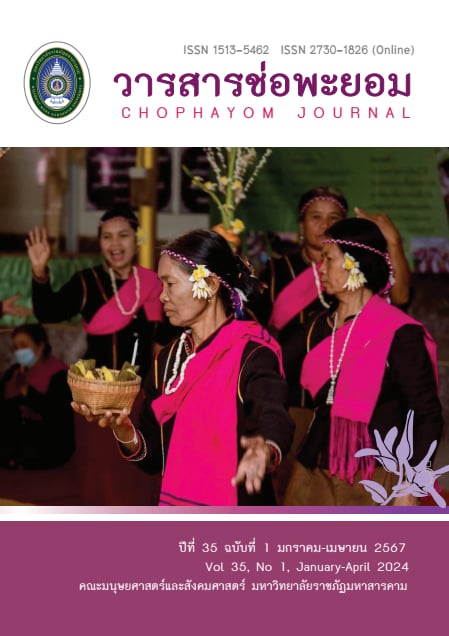The Development of Kaedum Community Cultural Capital Using Collaboration Mechanism for Community Econnomic Development
Keywords:
Product Design, Cultural Capital, Cultural MappingAbstract
This research objective is to create a cultural capital database using cultural mapping to promote the value of arts and culture, with the aim of increasing community income through the development of cooperation mechanisms and cooperation plans with the main sectors as follows: 1) Local Administrative Organizations, 2) 13 Communities in 5 sub–districts, 3) Artists and craftsmen 4) Private sectors 5) Academic researcher 6) Government agencies 7) Civil society organizations. Through the management of arts and cultural capital, the development of entrepreneurs, cultural enterprise development, and the development of arts-cultural products and services, lead to the growth of grassroots economic value, elevating local consciousness towards societal resilience that can be economically assessed reasonably. The operational plan is divided into 5 phases. The underlying concept used in the research is Engage-Enrich-Enhance, which drives cultural capital for area development based on cooperation. The operations resulted in 32 cultural products and services, categorized into 15 cultural products and 17 cultural services.
The study found that the cultural capital appears mostly in the category of traditional craftsmanship, local literature, natural resources, architecture, knowledge and guidelines related to nature and the universe, social norms, ceremonies, festivals, art performances, and historical sites. In terms of strengthening cultural capital values through cooperation mechanisms, various sectors including the government, communities, private sector, and civil society organizations have participated. Furthermore, the project has generated social returns and investment returns, with the value of changes resulting from the project over 5 years from 2021 to 2025 showing a Social Return on Investment (SROI) of 3.79 Baht per 1 Baht investment, and a Return on Investment (ROI) which is a net profit from products and services developed by the project showing an investment return rate of 44.16%. In summary, cultural capital plays a crucial role in community economic development. Community participation through integrating cultural capital as a bridge to community activities, leading to shared learning and driving sustainable community self-reliance.
Keywords: Product Design, Cultural Capital, Cultural Mapping
References
กรมการปกครอง. (2564). จำนวนประชากร ระบบสถิติทางการทะเบียน. สืบค้นเมื่อ 19 กุมภาพันธ์ 2567, จาก stat.bora.dopa.go.th.
กาญจนา สุคัณธสิริกุล. (2558). การพัฒนาศักยภาพการตลาดบริการของโฮมสเตย์ที่ได้รับรองมาตรฐานในจังหวัดนครราชสีมา. จังหวัดนครราชสีมา: มหาวิทยาลัยเทคโนโลยีสุรนารี.
เกริกกฤษณ์ โชคชัยรัชดา. (2565). บ้านแกดำ. สืบค้นเมื่อ 19 กุมภาพันธ์ 2567, จาก https://wikicommunity.sac.or.th/community/457.
ชยันต์ วรรธนะภูติ. (2541). การวิเคราะห์ข้อมูลในการวิจัยเชิงคุณภาพ. ในเอกสารประกอบการอบรมการวิจัยเชิงคุณภาพเพื่อพัฒนา อนุรักษ์ทรัพยากรธรรมชาติและสิ่งแวดล้อม(หน้า 93-138). ชลบุรี: โครงการจัดตั้งสถาบันวิจัยและพัฒนา มหาวิทยาลัยบูรพา
ชวน เพชรแก้ว. (2547). การยกระดับและการปรับใช้ภูมิปัญญาท้องถิ่นในสถานการณ์ปัจจุบัน. วารสารสารภาษาไทย.
ดนุพล ปันธินวน. (2552). การพัฒนาเศรษฐกิจชุมชนกรณีศึกษา อำเภอลี้ จังหวัดลำพูน. เชียงใหม่: คณะเศรษฐศาสตร์มหาวิทยาลัยเชียงใหม่.
ไปรมา อิศรเสนา ณ อยุธยา และ ชูจิต ตรีรัตนพันธ์. (2560). การคิดเชิงออกแบบเรียนรู้ด้วยการลงมือทำ. กรุงเทพฯ: ศูนย์สร้างสรรค์งานออกแบบ.
Downloads
Published
How to Cite
Issue
Section
License
Copyright (c) 2024 Chophayom Journal

This work is licensed under a Creative Commons Attribution-NonCommercial-NoDerivatives 4.0 International License.






